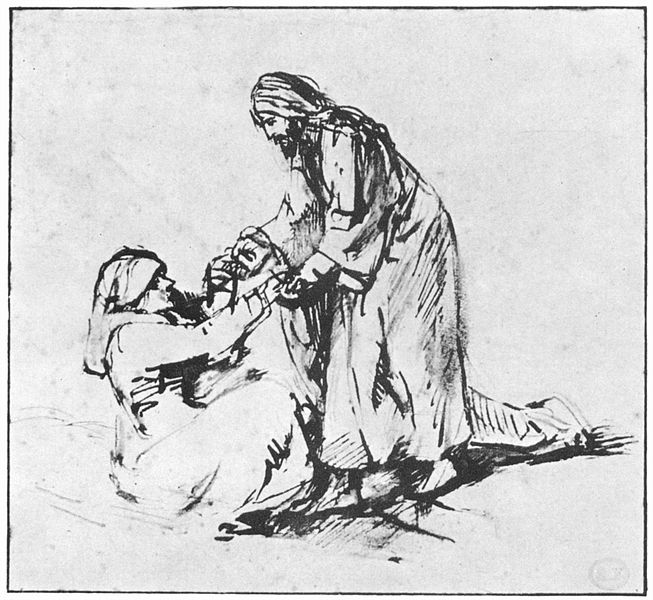After leaving the synagogue he entered Simon’s house. Now Simon’s mother-in-law was suffering from a high fever, and they asked him about her. Then he stood over her and rebuked the fever, and it left her. Immediately she got up and began to serve them. — Luke 4:38-39
I’ve always had a sneaking sympathy for Simon’s mother-in-law. Frequently mothers-in-law are the topic of bad jokes, hurtful comments, or scorn. But just as often, mothers-in-law are loved, respected, and invaluable helpers. With Simon’s, I’m not sure which was the case.
She isn’t even important enough to give her a name, just her relationship to a relatively important character. She makes a very brief cameo appearance, without a word being spoken. Yet, she does, even briefly, take center stage in a miraculous recovery and a testimony to the power of Jesus.
She was suffering from a high fever, a signal of something severe, in a time when antibiotics and pain relievers were unknown, for the most part. Imagine being sick and not being able to take medicine to fight the illness, manage the fever, and accompanying discomfort. Healers could try their limited resources of herbs, but sometimes they didn’t work. Peter must have loved his mother-in-law (or at least his wife) to ask Jesus to come to his house to help. Perhaps the offer of lunch or a hearty snack accompanied by wine was a lure, but probably it was merely native hospitality since Peter lived near the synagogue.
Undoubtedly Jesus knew of the illness by this time and very probably offered to help. Immediately after he rebuked the fever (which people associated with possession of evil in those days), the mother-in-law immediately got out of bed and headed for the kitchen to cook for the whole group as if she’d never been ill.
That’s where I find myself wondering about the episode. Granted, I know that Jesus had healed many people who folded up their blankets, got up and walked, or who immediately were able to see or hear. Where my pensiveness comes in is when I consider that the crippled, the people with epilepsy, the deaf, and the blind, even the woman hemorrhaging, had been suffering their various disabilities for long periods. Most of those were able to get around in some fashion as they had learned to do for years. For those with illnesses like severe flu, infections, recovery from surgery, or COVID-19, find that one doesn’t just pop out of bed like a jack-in-the-box and pop back into the kitchen to make a good meal for a group of people as if nothing had happened. Most of us would barely be able to crawl out of bed to relieve ourselves or even move to the couch by the television. It may take several days to recover enough to feel halfway normal. Still, Jesus’s healings seem to have been complete, even to the point of returning the person to absolute normalcy instantly.
I bet many wish they could have such healing from Jesus. People with painful cancers often suffer great pain that even the most potent pain relief treatments can’t ease. Those with breathing problems gasp for air, even when sucking on oxygen provided by tanks and machines that force the air into diseased lungs. Many hereditary diseases and syndromes cause pain, even to small children, that are difficult or even impossible to treat. Older adults, crippled by strokes and compounded by various dementias, can do nothing but lie in bed and simply wait for death. We often pray to Jesus for deliverance for all of these, but it seems Jesus has a deaf ear, because nothing happens – or does it?
There are times when, if we happen to think of it, we might wish that we had Peter for a father, brother, son, or son-in-law. We’d even take him as an uncle or a cousin five- or six-times removed, so that we could claim him as a family member and ask for his help that way.
We can call Jesus our brother, and we do ask for his help in times of trouble, stress, pain, and anguish. If we can, we consult the best doctors, take the best treatments and medications, and hope for good results. Still, even when hope dims, a tiny flicker of it fights for life, like a guttering candle.
Perhaps the point of Peter’s mother-in-law wasn’t so much about an ill and useless person being healed and jumping up to return to normalcy in minutes as it was about trusting Jesus to perhaps not cure us of our illnesses and diseases, but to heal us of our need to control everything in our life. There’s a big difference between the two states – healing and curing. A cancer can be cured, and the person can go into remission, but the person can also have the disease and put it in God’s hands, to hand it over, to trust God to do what is best, regardless of how it turns out.
Peter’s mother-in-law was both healed and cured. So was Lazarus, the woman with the hemorrhage, the man let down through a hole in the roof, and many others in the gospels. They were cured of their illnesses, diseases, and even lifelessness. Still, they were healed so that they could return to everyday life as testimonies to God’s grace and Jesus’s healing.
God bless.
Image: Christ Healing Peter’s Mother-in-Law, Rembrandt, painted ca 1650-60. Found at Wikimedia Commons
Linda Ryan is a co-mentor for an Education for Ministry group, an avid reader, lover of Baroque and Renaissance music, and retired. She keeps the blog Jericho’s Daughter.

